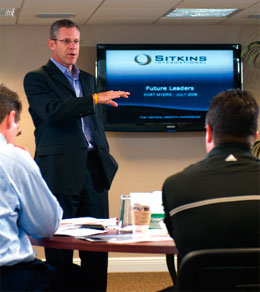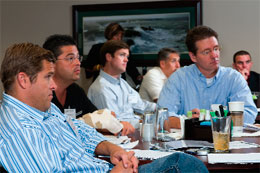|
Leading for tomorrow
Sitkins coach delivers straight talk about new management imperatives
By Elisabeth Boone, CPCU
Wikinomics … prosumerism … social networking … branding …
If these terms don’t sound like insurance buzzwords, it’s for a good reason: They’re not.
What they are is the language of the new marketplace for insurance and just about everything else, where product and service take a back seat to creating the client experience.
That message was delivered forcefully to 15 members of Sitkins International who attended the Future Leaders workshop in Fort Myers, Florida, in July 2008. Led by Sitkins President Larry Linne, the two-day session delivered a knockout punch to old paradigms of insurance as a commodity and leadership as an entrenched bureaucracy.
“Wiki” is Hawaiian for “quick,” and the fast-paced Future Leaders program embodied that concept, exposing participants to a myriad of new concepts in marketing, communications, and management, and helping them assemble a kit of powerful tools for peak performance.
Attendees ranged in age from the late 20s to 50-something and came from agencies all around the country as well as Canada.
The future leaders of independent agencies face a daunting array of challenges, and that reality was reflected in the workshop’s ambitious agenda. At each step, attendees completed an assessment of the state of their agency, shared their problems and solutions, and formulated plans to address key issues. Agenda items were vision, industry problems, leadership, finance, performance management, strategic planning, hiring, and second in command.
The wiki effect
A voracious reader, Linne quoted from a variety of management, leadership, economics and marketing books during the session. First on his list was Wikinomics: How Mass Collaboration Changes Everything, by Don Tapscott and Anthony Williams. Citing the astronomical growth of online communities worldwide, in which ordinary people are cooperating to create everything from TV news to software, the authors explain how smart entrepreneurs can harness this power to drive innovation, growth, and profits.
“If you don’t understand wikinomics,” Linne declared, “you will struggle in the business world over the next four or five years. Wikinomics and social networking are the future of business.”
For those who think social networking is merely a vehicle for young people to meet up and trade gossip online, Linne cautioned, think again: Social networks are emerging as a powerful, sophisticated tool for business communications; and leading-edge agencies are using social networks to interact with clients, launch discussion forums, and create sub-networks of interest groups.
“Your clients are more at risk of being lost in the next hour than ever before,” Linne asserted. “On social networks, clients can quickly and easily get information from your competitors about other risks and solutions.”
Since the late 1960s, the dominant force in marketing has been consumerism: driving people to buy goods and services by touting their appeal in myriad ways. Today, Linne told attendees, consumerism has given way to “prosumerism.” Introduced by Future Shock author Alvin Toffler in the 1970s, prosumerism is the process by which consumers become producers, in effect telling the market what products it should create. Today, Linne explained, savvy marketers are using wikinomics and social networking to invite input from customers in the prosumerist-focused product design process.
“Our product is not insurance,” Linne told attendees. “What we are selling is a consumer experience.”
The most frequently cited example of this concept is Starbucks. The giant chain doesn’t simply sell coffee; instead it sells “the Starbucks experience,” using furniture (big cozy chairs grouped for conversation), music (worldbeat, jazz), technology (Wi-Fi for Net surfers), and appealing displays of take-home products (mugs, cookies, tea, coffeemakers).
Store associates, called baristas, represent a diversity of ages and ethnic backgrounds and are friendly, enthusiastic, and knowledgeable. The custom-brewed coffee is invariably excellent, but that’s not really what keeps customers coming back; good coffee is available on almost every corner. People return because they want to repeat the Starbucks experience, of which coffee is just one component.
“What experience do you want your clients to have?” Linne asked attendees. “What’s the product you sell and deliver to clients?” In all businesses, including insurance, he said, the client experience that a firm creates is becoming increasingly important. “You could probably take your agency where you want to go simply by defining your client experience.”
As agency leaders, Linne told attendees, “You must constantly define, communicate, and manage your client experience.” The client experience, he said, embodies everything from the tangible—billing, paperwork, signs—to the intangible: management’s interactions with producers, CSRs, and other employees. When an agency’s client experience is effectively designed and presented, Linne explained, “Once people become clients, they never want to leave, and price isn’t an issue because your services are so valuable.”
Cohesive management
“Our industry is built on great sales talent,” Linne told the future leaders. As a result, he observed, “Producers as managers grow their business beyond their ability to manage it.” In this environment, Linne said, it is vital for agency leaders to create and maintain a cohesive management team. “This is the most important thing you can do as a leader,” he declared. “Anything that distracts from cohesiveness distracts from your ability to lead.”
Linne identified five rules for a cohesive management team, the first of which is “no politics.” Politics, he said, is “saying things you think someone else wants to hear.” He cited as an example the Watergate scandal of the Nixon administration. “Not one person wanted to bug the Democratic Party headquarters, but everyone thought everyone else wanted to do it,” Linne said.
Rule 2 is to challenge ideas with which you disagree, and Rule 3 is to own the ultimate decision whether or not you agree with it. “If you oppose an idea, challenge it—but if the decision doesn’t go your way, leave the room owning the decision,” Linne told attendees. “Never speak outside the room about your opposition.”
The fourth rule, he said, is: “The management team is the first team. Here you’re not a producer or a sales manager. Don’t give your team confidential information from a management meeting.”
Rule 5 is to be committed to achieving results. To gain insight into the practice of cohesive, committed management, Linne encouraged the future leaders to read The Four Obsessions of an Extraordinary Executive: A Leadership Fable by Patrick Lencioni.
In independent agencies, managers are almost always drawn from the ranks, and Linne offered this observation and advice: “Over time, a CEO who rose from the ranks will become separated from the ability to communicate with employees,” he said.
That CEO, he noted, needs a second in command—someone “who can clarify your general message and interpret what it means to individual employees.” Linne details this concept in his forthcoming book, Make the Noise Go Away: The Power of an Effective Second in Command.
Clarity rules
Both within and outside the agency, Linne said, it’s vital to establish, implement, and communicate organizational clarity with respect to the agency’s vision, culture, desired end results, brand, client experience, and product. First, he said, “When an employee comes to work, he should have no doubt about what he is supposed to do.”
When asked to describe the agency’s brand and desired client experience, Linne continued, “Every employee should give the same answer.” A brand, he explained, is “the clear, powerful, and positive thoughts you want people to have about you. It should be purposeful, different, and valuable.”
Lack of clarity about what is expected, Linne told attendees, is the most common reason that employees do not perform as desired. Employees, he said, want three things from their supervisor: (1) How am I doing? (2) What is going on in the agency? and (3) recognition for what they do well. “Catch employees in the act of doing something right,” he advised.
Each employee’s tasks, Linne said, should be specified in a job description. Too often, he said, “Employees are totally disconnected from management’s goals. They need performance objectives.”
Linne identified and described five SMART objectives for employees: Specific (who does what, and when), Measurable, Attainable, Relevant, and Trackable. This approach, he said, “gives employees absolute clarity about what’s expected.” The goal of performance management, Linne emphasized, is “helping people become better at what they do.”
In this regard, he said, supervisors should communicate frequently and directly with subordinates. “Have frequent conversations with people about what’s important, what they should be doing, and why it’s important,” he said. “Tell employees what’s in it for them.
“People no longer work for one company for 40 years,” Linne said. “Every day they ask: ‘Why am I here? What am I getting from my job?’”
What the numbers say
A highlight of the Future Leaders workshop was a presentation titled “Financial Management of Insurance Brokers” by CPA Tom Sukay, president of Sukay & Associates in Naples, Florida, which provides merger and acquisition advisory and consulting services to insurance agencies.
Sukay outlined the key components of an agency’s balance sheet and income statement, explained the factors that influence the compensation and benefits ratio, and described performance measurement standards: revenue growth, contingencies and overrides, compensation and benefits as a percentage of revenue, and operating expenses as a percentage of revenue.
Addressing the merger and acquisition issue, Sukay said: “Buyers are not interested in agencies that are having financial difficulties. The interesting factor is that profit margins that are unusually high are as difficult to deal with in a sale as unusually low profit margins.”
Cautioning attendees against selling in haste and repenting at leisure, Sukay said: “We believe that all sellers should engage in a full financial review before speaking with any potential buyer. We see many agencies that are sold where the benefits of financial and operational decisions are achieved by the buyer and not the seller.”
After their jam-packed two-day workshop, the Future Leaders participants had workbooks filled to overflowing with ideas, inspirations, and to-do
lists. Back in the office, the agents will be able to continue their dialogue via a networking site created for participants in every category of training session offered by Sitkins International. At Sitkins, the name of the game is networking, and it’s being played at the highest level by enthusiastic coaches and motivated members. *
For more information:
Sitkins International
Web site: www.sitkins.com
|
|
| |
 |
| |
“What you do for a living is the distribution system for your unique talents.”
—Larry Linne
President
Sitkins International
|
| |
 |
| |
Attendees at the Future Leaders workshop consider the problems and solutions confronting their respective agencies. |
|